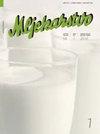Genetic polymorphism and effect on milk production of CSN2 gene in conventional and local cattle breeds in Croatia
IF 1.1
4区 农林科学
Q3 AGRICULTURE, DAIRY & ANIMAL SCIENCE
引用次数: 12
Abstract
Over the past three decades, the scientific and public interest has been initiated by studies in which the negative effect of milk consumption of beta-casein A1 variant has been observed on consumers’ health. The production of “A2 milk” is one of the ways to economically increase the competitiveness of small and medium-sized dairy farms. Breeders of endangered local breeds are also interested in reaffirmation through production of “A2 milk”. The aim of this study is to determine frequencies of A1 and A2 variants of beta-casein in three commercial and three local breeds of cattle in Croatia, and their relationship with production indicators of commercial breeds in the first three lactations. The genomic DNA was extracted from hair and determination of CSN2 genotypes was conducted by PCR RFLP method. Data for milk yield and chemical composition were provided by the central database. The dominant presence of A2 variant beta-casein in the investigated cattle breeds (0.650-0.758) and the increase in the frequency of A2 beta-casein in the population of Simmental and Istrian cattle were determined. The association of A2A2 and A1A1 genotypes of beta-casein with lactation production and milk fat content in the first and second lactation was observed (p<0.05). The dominance of the A2 allelic variation of beta-casein makes the researched conventional and local breeds suitable for the production of “A2 milk”. The breeding extension of A2 allelic variation of beta-casein within local cattle breeds should be carried out carefully trying not to lose part of the existing genetic variability.克罗地亚传统和地方牛种CSN2基因的遗传多态性及其对产奶量的影响
在过去的三十年里,科学和公众的兴趣已经开始研究,在牛奶消费的β -酪蛋白A1变体已经观察到对消费者健康的负面影响。生产“A2奶”是提高中小奶牛场经济竞争力的途径之一。濒危地方品种的饲养者也有兴趣通过生产“A2奶”来重申。本研究的目的是确定克罗地亚三种商品品种和三种地方品种牛中β -酪蛋白A1和A2变体的频率,以及它们与前三次哺乳期商品品种生产指标的关系。从毛发中提取基因组DNA,采用PCR - RFLP法测定CSN2基因型。产奶量和化学成分数据由中央数据库提供。测定了A2变异β -酪蛋白在被调查牛品种(0.650-0.758)中的优势存在,以及在西门塔尔牛和伊斯特拉牛群体中A2 β -酪蛋白的频率增加。β -酪蛋白A2A2和A1A1基因型与泌乳量和乳脂含量有显著相关性(p<0.05)。β -酪蛋白A2等位基因变异的优势使所研究的常规和地方品种适合生产“A2乳”。在地方牛品种中,β -酪蛋白A2等位基因变异的育种推广应谨慎进行,尽量不失去部分现有的遗传变异。
本文章由计算机程序翻译,如有差异,请以英文原文为准。
求助全文
约1分钟内获得全文
求助全文
来源期刊

Mljekarstvo
Agricultural and Biological Sciences-Animal Science and Zoology
CiteScore
1.90
自引率
41.70%
发文量
18
审稿时长
12 weeks
期刊介绍:
Mljekarstvo is an open access, peer-reviewed international quarterly scientific journal. The first issue was published in 1951, by the Croatian Dairy Operators'' Association (today: Croatian Dairy Union, publisher). In a paper at a Union conference held 28 October 1951 in Zagreb it was said: "Our desire is that this magazine does not meet the fate of its predecessors, but that it continues to reflect the creative efforts and to provide guidelines for the producers as well as all other operators employed in the dairy industry."
It is our pleasure today to say that wishes of the enthusiasts who attended the conference have come true, and the magazine Mljekarstvo during the last six decades was a reflection of the creative efforts of numerous dairy scientists and experts, and through its texts it served as a guideline in improving production and processing of milk and dairy products. Mljekarstvo has been following all the achievements of the dairy profession in Croatia, and it also gives the short surveys of world achievements. The result of the research of local and foreign scientists and experts always find their place in the magazine Mljekarstvo. It has been edited by our outstanding dairy experts employed at colleges, research institutions and dairy companies.
 求助内容:
求助内容: 应助结果提醒方式:
应助结果提醒方式:


